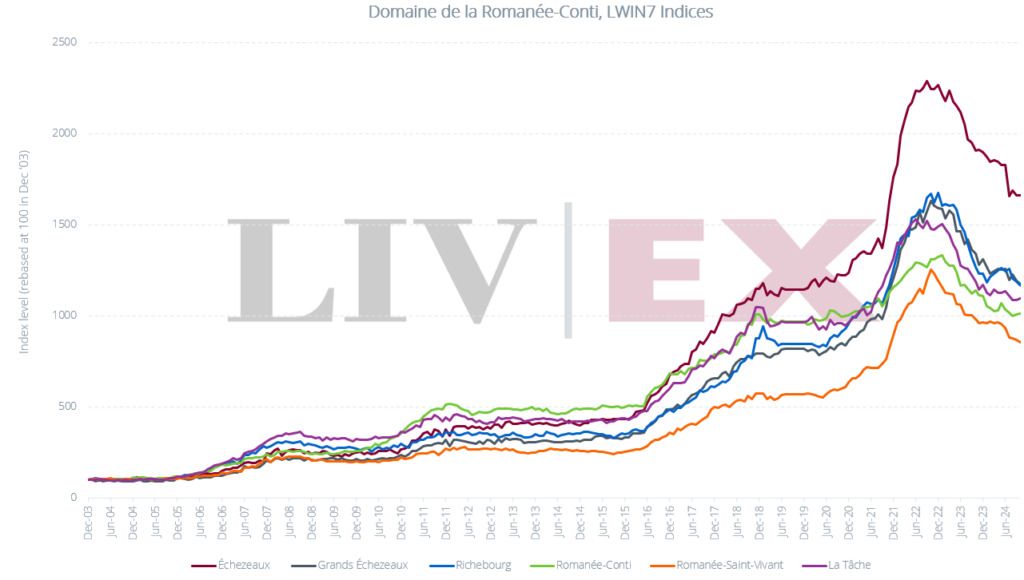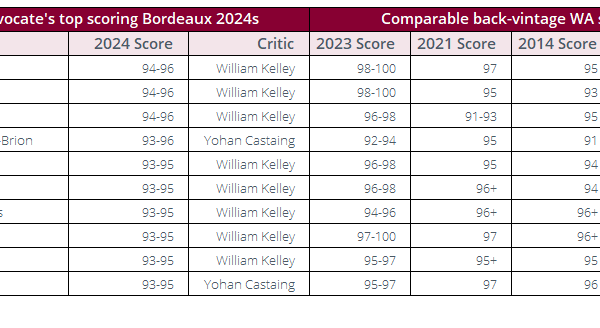What’s happening in the market?
Fittingly, Domaine de la Romanée-Conti is the top-traded producer of the week so far, accounting for 16.8% of trade. Alongside 2020 horizontal assortment cases, the 2020 Montrachet Grand Cru and 2019 Grands Échezeaux changed hands.
Château Angelus is following as the second top-traded producer, with the 2012 vintage trading most actively.
Today’s deep dive: which DRC wines are driving the index down?
In our previous coverage of the Domaine de la Romanée-Conti (DRC) index (June, August, September), we have reported that technical analysis indicators appear to suggest prices, overall, have further to fall. Today, breaking down the DRC index into its six component wines, we take a closer look at which wines are driving the index’s trends, and where buyers may find pockets of relative stability.

All DRC wines have seen dramatic price increases over the past 20 years. Even the least impressive climber, DRC’s Romanée-Saint-Vivant, has appreciated by 756%. By comparison, the Liv-ex Fine Wine 1000, also included in the chart below, sits 278% above its 2004 level.
Still, it is clear from the above chart that Échezeaux has exhibited significantly higher volatility than any other DRC wine, its index rising very sharply in mid 2021 to a peak index level of 2,268. With the fine wine market quickly gaining upward momentum in 2021, buyers seeking to capitalise on high-margin wines likely chose Échezeaux as the cheapest brand entry point. As such, its demand was driven upwards. 38% more trades of Échezeaux took place in 2022 than in 2021. La Tâche had a higher number of trades than Échezeaux in both years, but the number of trades decreased by 18% over the same period.
Technical analysis indicators by wine
So far, on a cross-vintage basis, no DRC wines have fallen into oversold territory (indicated by a Relative Strength Index level below 30). All, however, have fallen below their short and medium term Simple Moving Averages (7-, 20-, and 50- month). The table above shows each index’s current index level, alongside its long-term 100-month SMA, which has been identified as the next potential support level. The volatility of each index, as indicated by Bollinger Bands, remains high. Though far from price squeezes, which would suggest the imminence of a trend reversal, the Lower Bands of Romanée-Conti and La Tâche have been trending slightly upwards for the past three months.
While technical analysis suggests Grands Échezeaux, Richebourg, Romanée-Saint-Vivant and, in particular, Échezeaux, have further to fall, there is some indication that Romanée-Conti and La Tâche are closer to their price floors.
For those with enough capital available, technical analysis suggests DRC’s eponymous Romanée-Conti may present an interesting opportunity. Given its high price tag, even during times when the cost of capital has been lower and the market’s momentum upward, it has not been as subject to overbuying as more accessible wines. The Romanée-Conti index increased more mildly from mid 2021 to the peak of the market than any other DRC index. As such, technical analysis suggests it may find support at the convergence of its long-term SMA100 and 2021 lows (around the 990 index level) sooner than the other indices.
Romanée-Conti’s illiquidity, relative to other DRC wines, however, may have a negative effect on its price volatility. La Tâche has traded more frequently and in higher volumes than any other DRC label, with four vintages – the 2006, 2015, 2017 and 2009 –amongst the top five DRC wines by number of trades. As shown in the charts below, La Tâche 2006 trades and sells at auction more consistently than Romanée-Conti 2006. As a result, while La Tâche is more subject to market conditions, prices of Romanée-Conti exhibit less short-term stability. So far this year, single loose bottles of Romanée-Conti 2006 have auctioned between £13,075 and £15,180 (a 16% difference), while cases of La Tâche (in original packaging) have traded and auctioned consistently around £40,000 per 12×75.
Auctions and Liv-ex trades of DRC La Tâche 2006
Auctions and Liv-ex trades of DRC Romanée-Conti 2006
Liv-ex analysis is drawn from the world’s most comprehensive database of fine wine prices. The data reflects the real-time activity of Liv-ex’s 620+ merchant members from across the globe. Together they represent the largest pool of liquidity in the world – currently £100m of bids and offers across 20,000 wines.
Independent data, direct from the market.







